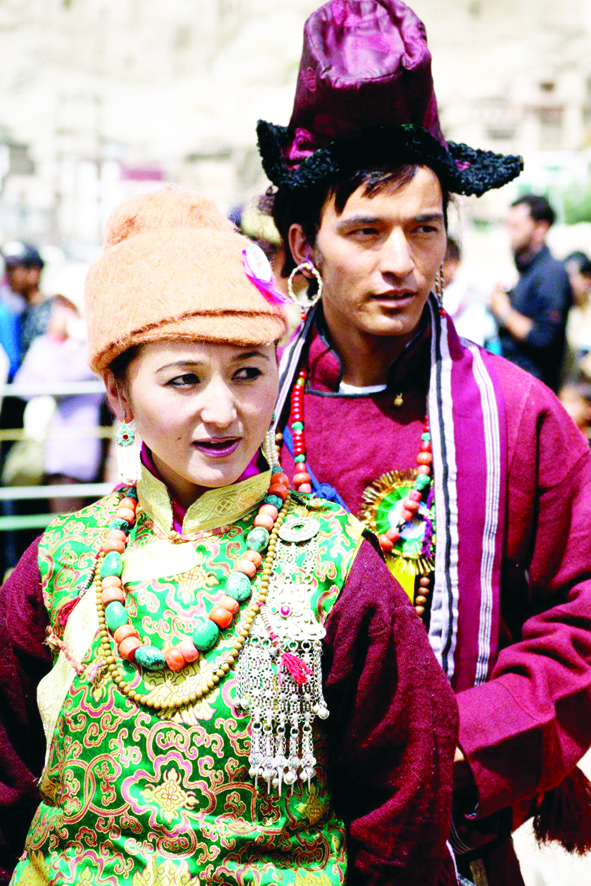Koss/ Goncha
This is a collection of articles archived for the excellence of their content. |
Koss
Thiles Norboo , Wearing the Koss "Daily Excelsior" 6/5/2018

"Daily Excelsior"
AzanglayLobzangDorjaywho sells traditional Ladakhi dresses in Leh market says, “Almost twenty years ago one day a foreigner came and asked me, “Are you from Ladakh?”I replied, “Yes, I am from Ladakh.”He further questioned me,”Where is your traditional dress – The Koss(traditional warm clothes of Ladakhi people) and why aren’t you wearing the dress while selling it.”
Azanglayfelt really ashamed of himself and after that incident he always wears the Koss.He feels that allLadakhi people should realize the importance of preserving their own tradition instead of being reminded by foreigners.
The ‘Koss’ is also known as ‘Gonchas’in Ladakhi.Koss basically came from Mongolia and originally had two types Gyazo and Bhotzoand in ancient times people used both.While the eliteclassof people used to wear Gyazo,the lay people used to wear Bhotzo. Later on Koss became one of the most important cultural identities of Ladakh which was worn on different occasions by people. The design differed for men and women. In ancient times people were wearing Koss every day as it would give not only warmth in harsh winters, but it would enhance the personality of the person wearing it. But, with rapid westernisation people started wearing western clothes and slowly began forgetting their own cultural dresses, losing a part of their culture.
In modern times each and every Ladakhi wants to be unique and that is the reason why they are seen copying the western styleof wearing torn clothes and dresses. If we really want to be unique we must wear our own dress which is so special that there is no one who will want to say they don’t have it.When I went to Nepal and Bhutan and wore the Koss, people came up to me and asked me which country I had come from. I proudly to old them that I had come from Ladakh, India and they took photos with me and I felt like a celebrity. So by wearing Koss not onlydoes one become unique which everyone really wants to be, but also it will help others to recognize and identify the people of this undiscovered yet beautiful region called Ladakh.
AcholayTsering Dorjay from Tukla laughingly says, “I really like to wear Koss but when I’m going to Leh town from our village, the dogs begin to bark at me and run after me as if I’m from another planet”.
Skarma Tsering,a student says, “To preserve our culture we have to wear our dress (Koss) but with this modern hectic time, it is very difficult to wear it becauseof the environment which has been created of not wearing traditional dressesevery time, and if I wear it every one looks at me and they start saying that I have gone mad. Though I always wear the traditional dress on special occasions like village festivals and when I am going for preaching and monastery visit. It is very important that we wear our dress otherwise one day we will lose ourown identity”.
Mrs.TsewangDolma says, “It’s not that I don’t like our traditional dress, the problem is that I find the Koss a little less comfortable to wear on a daily basis. However, I do wear it during functions and festivals.”
Mr.MepamOtsal former director of cultural academy Ladakh says, “Change is inevitable, similarly, if people find our traditional dress a little uncomfortable we can bring about some changes to the design to make it more comfortable and wearable”. He further adds, “Another thing is we have to encourage our children by saying that they look beautiful when they wear the traditional dress. Also, in order to make the younger generation adopt our traditional dress, first the elders have to be exemplary by wearing it often. There is a famous Ladakhi proverb “me chezer la manyanchecoatos” that means’never listen to what people say rather go by what they do’. This holds true for our traditional dress also”.
Although the people of Ladakh cannot be and should not be forced to wear their traditional dress, but one thing can surely be done collectively and that is to preserve it by wearing it on special occasions such as functions, festivals andreligious occasions.